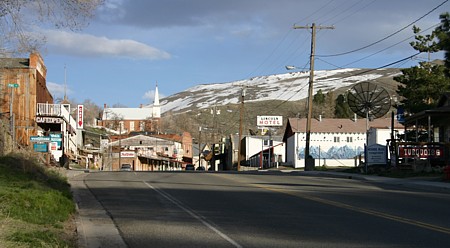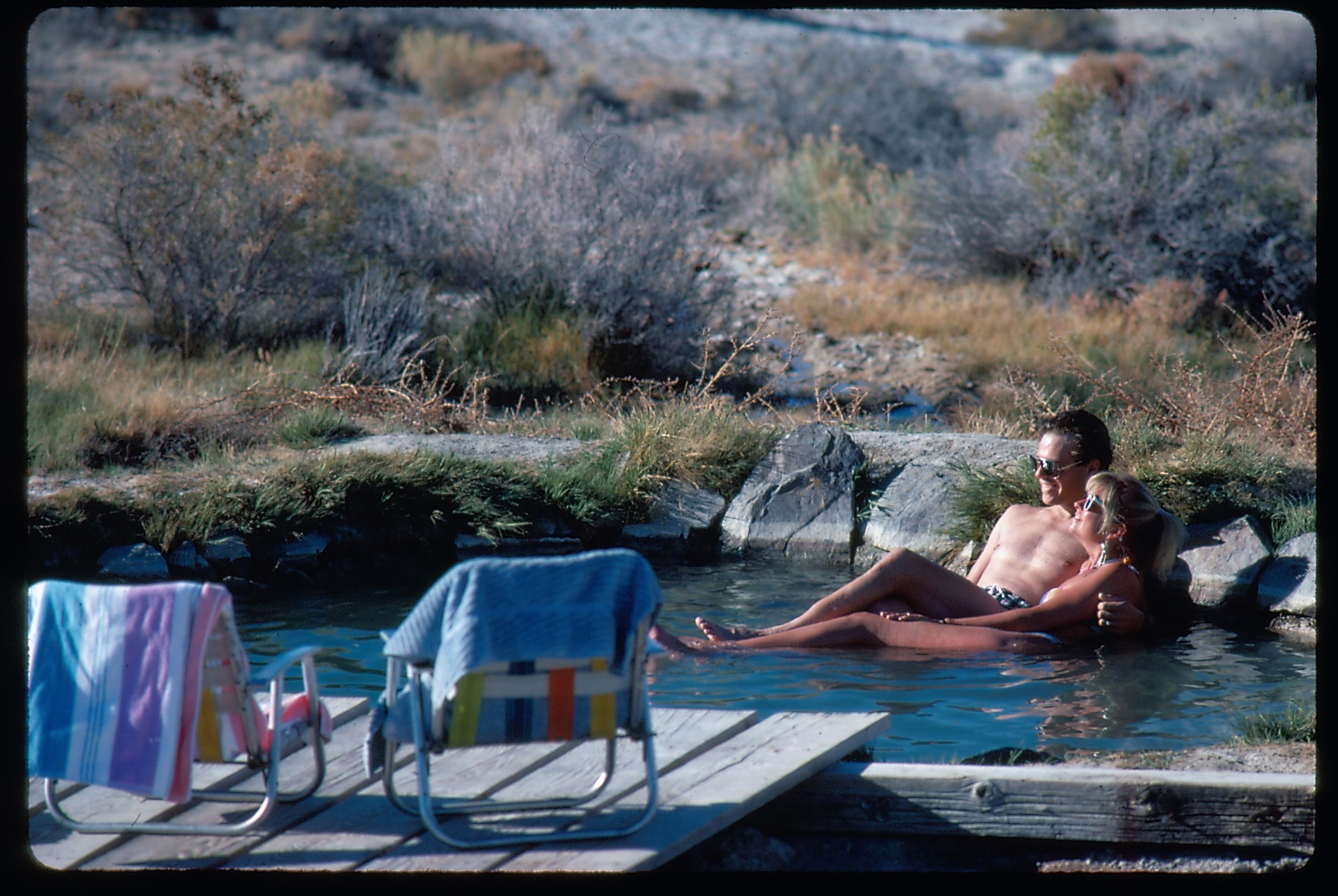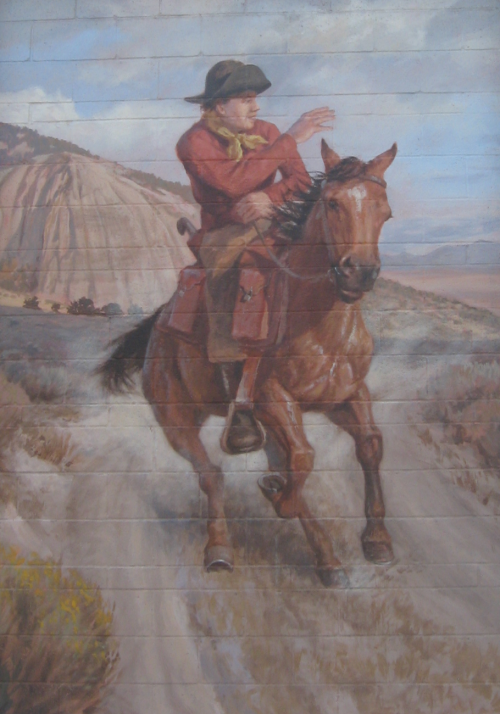Blue Highways: New Pass Station, Nevada
Unfolding the Map
Click on Thumbnail for MapA few miles west of Austin, Nevada we stop at the ruins of a Pony Express station. Besides having to ride hard and fast, the young riders had to be the model of efficiency, carrying very little. How I could learn from their example when traveling! How William Least Heat-Moon travels in style in Ghost Dancing! Tp see where New Pass Station is located, click on the map thumbnail at right.
Book Quote
"New Pass Station, under cliffs of the Desatoya Mountains and half an hour west of Austin, used to be a stagecoach stop...
"Regardless of the utter fierceness of desert winters and summers, the Pony Express riders, they say, always rode in shirt-sleeves; considering the real hazards of the job, that may be true. The Central Overland California and Pike's Peak Express (the actual name of the Pony Express) used to run notices that are models for truth in advertising. An 1860 San Francisco newspaper printed this one:
WANTED
Young, skinny, wiry fellows not
over eighteen. Must be expert
riders willing to risk death
daily. Orphans preferred.
"The only baggage the boys carried - in addition to the mail mochila - was a kit of four, cornmeal, and bacon, and a medical pack of turpentine, borax and cream of tartar. Not much in either one to keep a rider alive."
Blue Highways: Part 5, Chapter 8
 Ruins of stage/Pony Express stop at New Pass Station, Nevada. Photo at Nevada-Landmarks.com. Click on photo to go to host site.
Ruins of stage/Pony Express stop at New Pass Station, Nevada. Photo at Nevada-Landmarks.com. Click on photo to go to host site.
New Pass Station, Nevada
When driving across Nevada on Highway 50 last year, my wife and I passed a number of ruins that were the only remnants of stage and Pony Express stations. Because Nevada is so unpopulated, outside of its major population centers, there weren't very many people on the road or visiting these stops. We were on a schedule and didn't really stop either. But the vast empty distances of Nevada evoked a special kind of awe in me for people who rode alone across it. Knowing that they were all the same age as high school kids - kids who are going to soccer practice, playing video games on their game systems, listening to music on their music players, using their IPads and other types of modern activities - is almost mind boggling. I'm not arguing that we should send our kids out to jobs where they must be "willing to risk death," but just drawing a comparison. The definitions of "active kids" are quite different now.
What most impresses me about the quote above, however, is the packing. Perhaps it's because I just got back from a foreign trip where I once again overpacked that this topic is on my mind. I have never internalized the idea of packing light for any kind of endeavor. Granted, the Pony Express riders didn't really have any room to pack extraneous stuff, but they also made do with what they had. I'm sure that those riders who survived their tenure with the Pony Express packed light for travel the rest of their lives. If one learns how to pack light, and how to use what one has, then that habit stays with one for life.
Case in point. In Turkey, for a three week trip, I packed three pairs of jeans. Why? I only used one pair over and over. It's all I needed. I packed a beard trimmer, and never used it. I packed five t-shirts, and only really used two. I could have saved myself a lot of weight and possibly one bag and had a lot less hassle. Sarah, one of my trip companions and a journalist with our public radio station, impressed us all as she managed to pack light enough to have one bag of clothes and all of her radio equipment in carry-ons!
I once carried a full backpack all over Europe, filled with things that I could have easily gotten when I arrived but, because it was my first time, I packed with me because I was filled with dread that I wouldn't be able to find even the most basic supplies. I'm not that ignorant anymore, and won't pack easily obtainable things unless I go to a developing country where I know it will be difficult to find some items that I would need. But I still need to learn how to pack light.
The Pony Express riders had to be ready for anything. They had race across the wastelands as fast as they could to meet a schedule. They had to be light and quick so that they could travel fast, and elude pursuers such as unfriendly Native American tribes. The necessity to be unencumbered could mean the difference between life and death.
For me, in my travels, the choice is not that stark. For me it's the choice between being relatively free of hassles as compared to being weighed down by luggage. Not exactly a horrible thing, and a product of my lifestyle, which is much more well-off than that of the 19th century. However, even in the 1800s things changed pretty rapidly. The Pony Express lasted less than two years, then the railroad connected the west and east coasts and more mail could be carried farther and faster by locomotives. For travelers, the choice between bone-crunching and rattling stage rides and a comfortable seat in a fast-moving train was a no-brainer. Suddenly one could pack more to take with them, and many packed their whole lives in a few trunks and moved west.
As for me, I will try to keep the practice of the riders of the Pony Express in mind when I travel in the future. Light and quick. It'll make my travel more enjoyable, and just in case, I'll be light enough to elude any unfriendly pursuers. Okay, maybe I won't need to elude pursuers - but a guy can dream he's important enough to have pursuers, can't he?
Musical Interlude
When I was young, this song was all over the radio. I heard it so many times that even today, I can sing along to all the words. I think it might have been the only huge hit that Christopher Cross had. Though it's not about the Pony Express, the theme of riding fast to escape is appropriate. Enjoy Ride Like the Wind!
If you want to know more about New Pass Station
Flickr: New Pass Station
Forgtten Nevada: New Pass Station
HMSOA.org - New Pass Station
Nevada Landmarks: New Pass Station
State Historic Preservation Office
Next up: Frenchman, Nevada




 Wednesday, June 15, 2011 at 4:38PM
Wednesday, June 15, 2011 at 4:38PM



